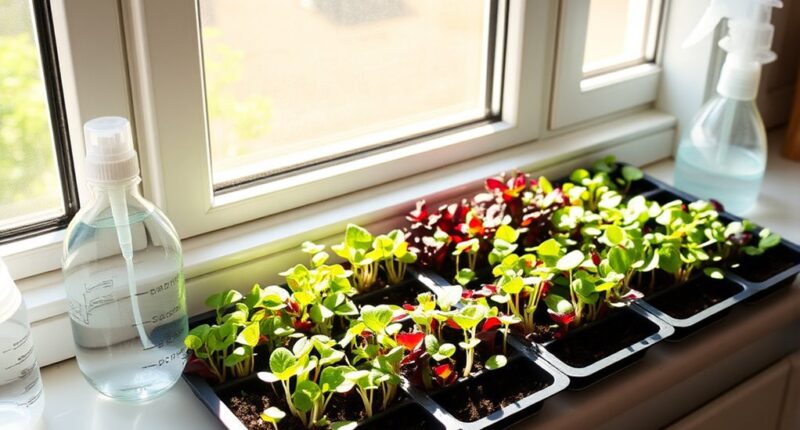To grow microgreens at home, choose fast-growing seeds like radish or broccoli and soak them overnight if needed. Use a hydroponic tray or container with water, keeping the seeds evenly spread and moist. Place the setup near a light source or under LED grow lights for 12-16 hours daily. Maintain consistent watering and light, and harvest your microgreens in about one to two weeks for fresh, nutritious greens. Keep exploring to discover more tips and tricks.
Key Takeaways
- Choose quick-growing seeds like radish, broccoli, or arugula and soak if needed for better germination.
- Use a soil-free hydroponic tray or container, evenly spreading seeds for uniform growth.
- Provide 12-16 hours of artificial LED light daily, placing lights 12-18 inches above microgreens.
- Keep the environment moist by misting or maintaining water levels, avoiding overwatering.
- Harvest microgreens in 1-2 weeks at their peak for maximum freshness and nutrition.

Growing microgreens at home is an easy and rewarding way to enjoy fresh, nutritious greens year-round. Whether you have limited space or a dedicated gardening area, you can start growing microgreens indoors using simple methods. One effective approach is utilizing hydroponic systems, which allow you to grow microgreens without soil. These systems typically involve a water-based setup where nutrients are delivered directly to the roots, making the process cleaner and more controlled. Hydroponic systems are especially useful if you want quick results and minimal mess, as they reduce the chance of soil-borne pests or diseases. You can choose from various types, such as trays with water reservoirs or more advanced setups with pumps and nutrient delivery systems. Whichever you pick, make sure it’s easy to clean and maintain, since microgreens are fast-growing and require regular attention. Additionally, integrating automation in business can help streamline your growing process by reminding you when to water or adjust lighting, saving time and ensuring optimal growth conditions. Lighting techniques play a critical role in successfully growing microgreens indoors. Since natural sunlight might be limited inside your home, you’ll need to supplement with artificial lighting. LED grow lights are a popular choice because they’re energy-efficient and can be tailored to emit the specific wavelengths needed for healthy plant growth. Position your lights about 12-18 inches above your microgreens, adjusting as they grow taller. Keep in mind that microgreens need around 12-16 hours of light daily to develop properly, so setting a timer can help automate this process. If natural light is available, place your trays near south-facing windows for maximum exposure, but be cautious of direct sunlight that can scorch delicate seedlings. Consistent lighting promotes even growth, vibrant color, and strong stems, which are all essential for high-quality microgreens. To get started with hydroponic systems and lighting, choose fast-growing seeds like radish, broccoli, or arugula. Soak the seeds overnight if recommended, then distribute them evenly in your hydroponic tray or container. Cover or mist them lightly to keep the environment moist. Set up your LED grow lights or position your trays in a well-lit area, and monitor the moisture level regularly. As the microgreens sprout, ensure they receive ample light and maintain the water level if using a hydroponic system. With consistent care, you’ll see your microgreens thrive in just a week or two, ready to harvest and enjoy. Growing microgreens at home with hydroponic systems and proper lighting techniques is straightforward, cost-effective, and offers a continuous supply of fresh greens to enhance your meals.
Frequently Asked Questions
What Is the Best Lighting for Microgreens Indoors?
You should use LED grow lights for the best indoor microgreens. They provide the ideal spectrum and intensity to promote healthy growth. However, if you have access to natural sunlight, placing your microgreens near a south-facing window can also work well. Just make sure they get about 4-6 hours of direct or bright indirect sunlight daily, or supplement with LED grow lights to ensure robust, vibrant microgreens.
How Often Should I Water My Microgreens?
Think of your microgreens as little dancers that need just the right rhythm. You should water them lightly daily, maintaining consistent moisture levels without overdoing it. Keep an eye on the soil; if it feels dry, it’s time for another gentle watering. A steady watering schedule helps your microgreens thrive, ensuring they stay healthy and vibrant, ready to impress with their growth.
Can I Grow Microgreens Without Soil?
Yes, you can grow microgreens without soil by using hydroponic systems or soil alternatives like coconut coir or paper towels. These methods allow you to sprout and grow microgreens indoors with minimal mess and effort. Just guarantee you provide adequate light and keep the growing medium moist. Hydroponic setups can boost growth speed, making it a convenient, soil-free way to enjoy fresh microgreens at home.
How Long Does It Take for Microgreens to Mature?
You can expect microgreens to reach harvesting timing within 7 to 21 days, depending on the growth stages and the variety you’re growing. Generally, they’re ready when the first true leaves appear and are about 1 to 3 inches tall. Keep an eye on the growth stages, and harvest at the right time for the best flavor and nutrition. Quick growth makes microgreens a fast, rewarding addition to your home garden.
Are Microgreens Safe for Pets to Eat?
You’re probably wondering if microgreens are safe for pets. Generally, many microgreen varieties are safe, but some can pose risks due to pet toxicity. Always identify the specific microgreens you grow and check if they’re non-toxic to your pets. Avoid giving them microgreens that could cause stomach upset or toxicity. When in doubt, consult your vet to guarantee your pet’s safety and enjoy your microgreens worry-free.
Conclusion
Growing microgreens at home is simple and rewarding, giving you fresh greens in just a few weeks. Plus, studies show microgreens can contain up to 40 times more nutrients than mature vegetables, making them a powerhouse for your health. By starting small, you can enjoy a continuous supply of vibrant, nutritious greens right from your windowsill. So go ahead—plant your microgreens today and reap the benefits of this easy, nutritious hobby!















